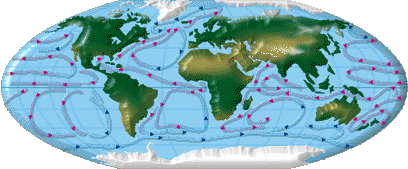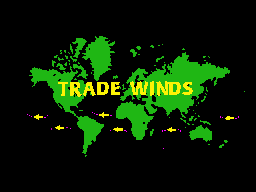 |
LESSON 5
AIM: WHAT ARE OCEAN CURRENTS?
MOTIVATION:
1. Ask students leading questions such as: Have you ever watched a sailboat move slowly across the water, and then all of a sudden it picked up speed? Why do you think this happened?
2. Direct students to go to the following link http://att.com/ehs/earth96/current.html and explain what they think this picture is showing. (This picture is taken from the above site).
 |
a. What do you think the red color stands for? (Warm currents).
b. What do you think the blue color stands for? (Cold currents).
c. What do you think sets the currents in motion? (The wind set in motion by the Earth's rotation, and the difference in water temperature from the poles to the equator).
PROCEDURE:
1. Introduce vocabulary:
Surface currents, Gulf Stream, Labrador Current, California Current, Trade Winds, Westerlies, rotation. Children can get the necessary information from either http://att.com/ehs/earth96/current.html or http://mbgnet.mobot.org/salt/motion/current.htm.
2 . Students will fill in two different data sheets. They can be placed in cooperative learning groups for this exercise. The roles can include researcher, reporter, writer, leader.
A. The first data sheet will be on the two winds that cause currents- the Westerlies and the Trade Winds. Children are to link to the following site for this information: http://mbgnet.mobot.org/salt/motion/current.htm and fill in the database. (This picture is taken from the above site).
 |
|
|
LOCATION |
|
|
|
||
|
|
|
|
|
|
| GULF STEAM | ||
| CALIFORNIA CURRENT | ||
| LABRADOR CURRENT | ||
| NORTH PACIFIC CURRENT |
a. What is a surface current? (Surface currents are ocean currents caused by wind. Prevailing winds have the greatest effect on surface currents. These currents are usually the same year after year, with warmer currents moving away from the equator, and colder currents moving toward the equator)
b. In which direction do surface currents flow in the northern hemisphere? (clockwise)
c. In which direction do surface currents flow in the southern hemisphere? (counterclockwise).
d. How do surface currents affect the climate of different lands? (They either warm the lands they pass or cool them off).
e. If Western Europe's climate was not affected by the Gulf Stream, what do you think its climate would be like? (Since Western Europe is much closer to the Artic, their weather would be much colder and the animal and plant life would be different.)
ACTIVITY:
In order to show how currents are caused by differences in water temperature, we can do the following experiment (in Scientific Method format). The following experiment was taken from Oceans For Every Kid, by Janice Van Cleave, John Wiley and Sons, Inc. 1996
Problem: What effect does temperature have on the motion of water?
Hypothesis: We think if cold water is heavier than warm water then it will sink, while warm water will rise. We think this temperature difference causes the ocean currents.
Materials: Two 2-liter soda bottles, one intact, one cut in half and use the top part, duct tape, measuring bowl, ice, marking pen, cold tap water, oak tag, paper hole-punch, warm tap water, red and blue food coloring, one bottle cap, spoon, and paper towel.
Procedure: 1. Label the whole bottle A and the top of the cut bottle B. 2. Fill the bowl 1/4 full with ice, and the rest with cold tap water. Add blue food coloring. Let stand for 5 minutes. 3. Cut a circle the size of the mouth of a soda bottle from the oak tag. 4. Cut two holes in the paper circle with the hole punch. 5. Fill bottle A with warm water, add red food coloring. 6. Place the paper circle over the mouth of bottle A, then place the mouth of bottle B upside down on top of the paper circle. 7. Secure the mouths of the two bottles with tape. 8. Pour the cold water from the bowl into bottle B. 9. Observe the movement of the colored waters.
Observations or Results: A stream of red, warm water rises from Bottle A into the cold, blue water of bottle B. The stream of blue, cold water from Bottle B is seen moving down into bottle A.
Conclusion: Cold water is heavier (denser) than hot water, causing the cold water to sink below the warm water, and pushing the warm water up. The up and down movements of water cause the ocean currents.
FOLLOW-UP: This lesson will lead into the next lesson " What are some marine animals?"